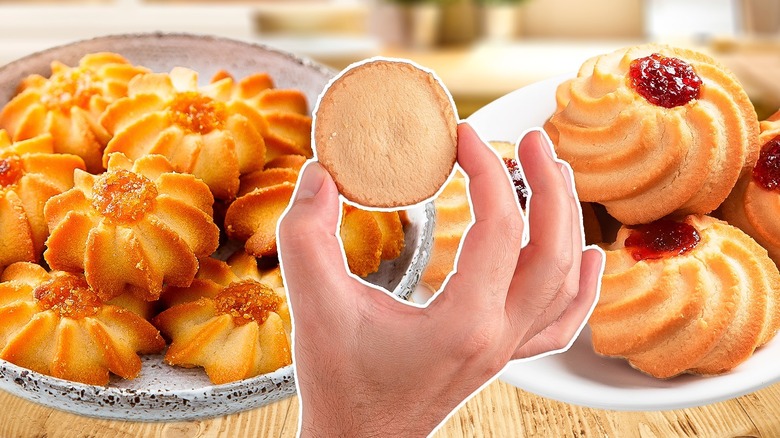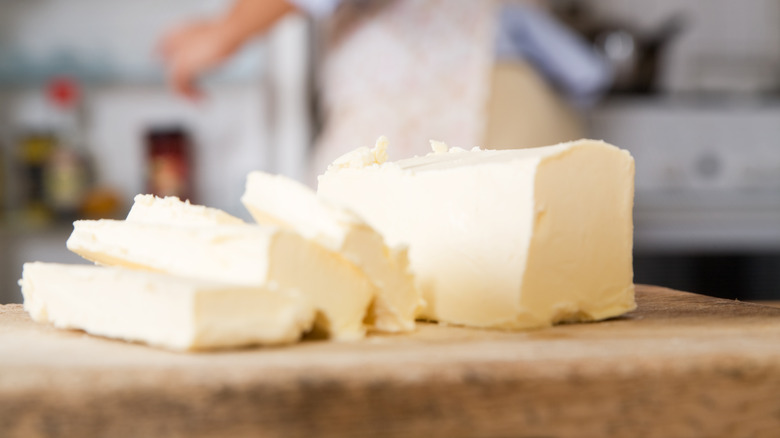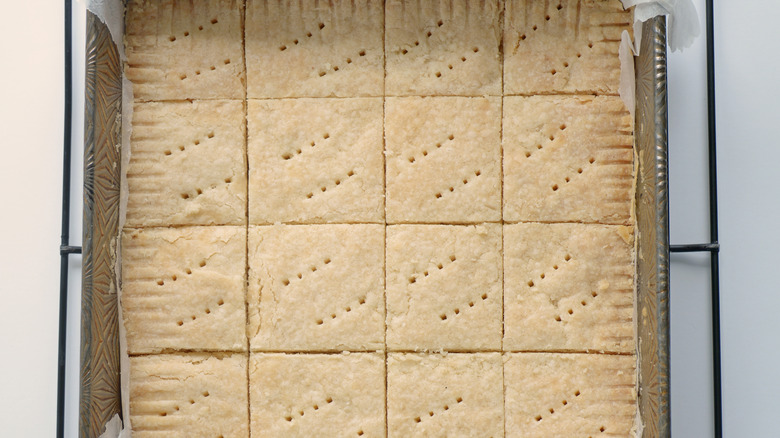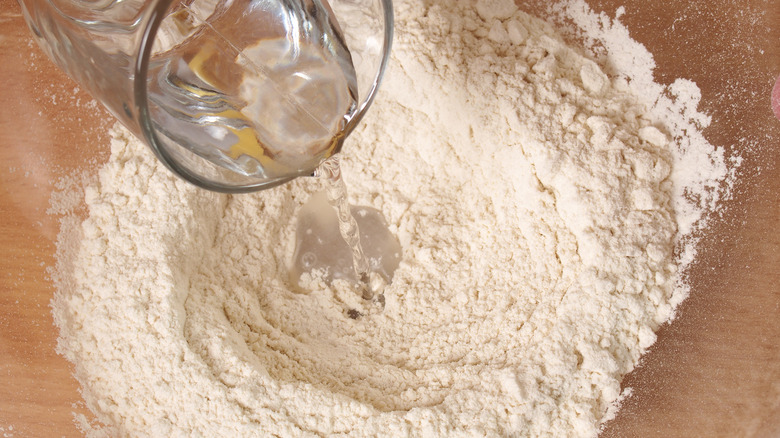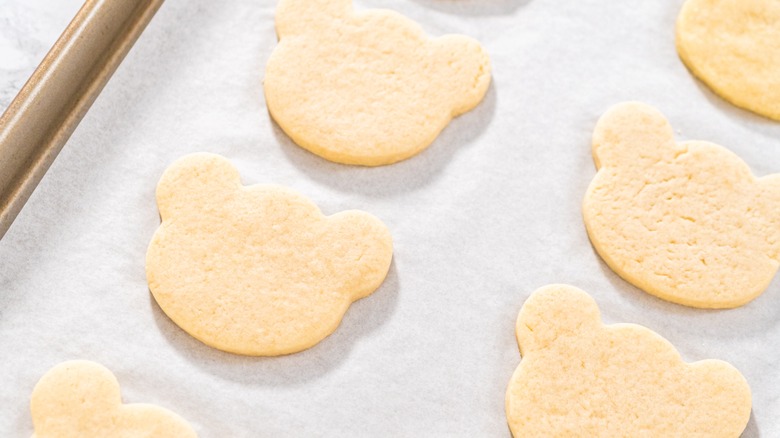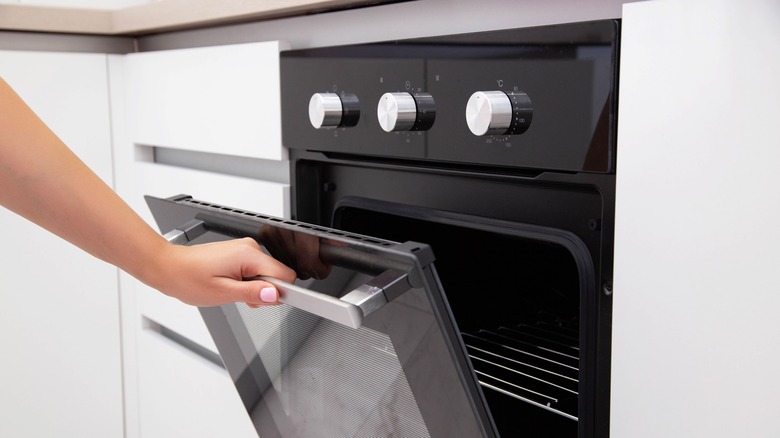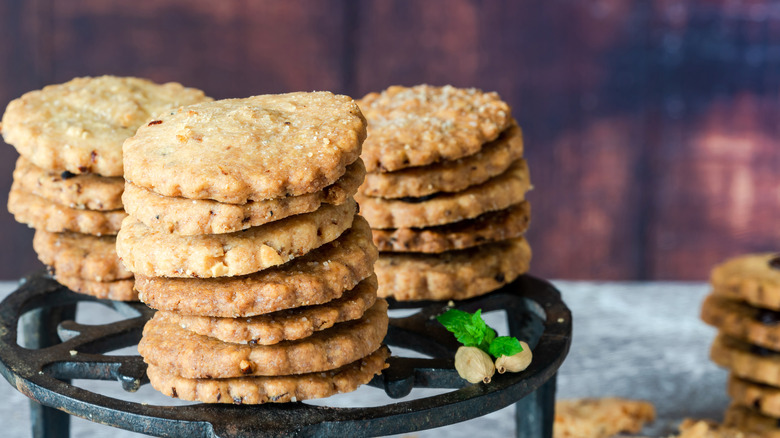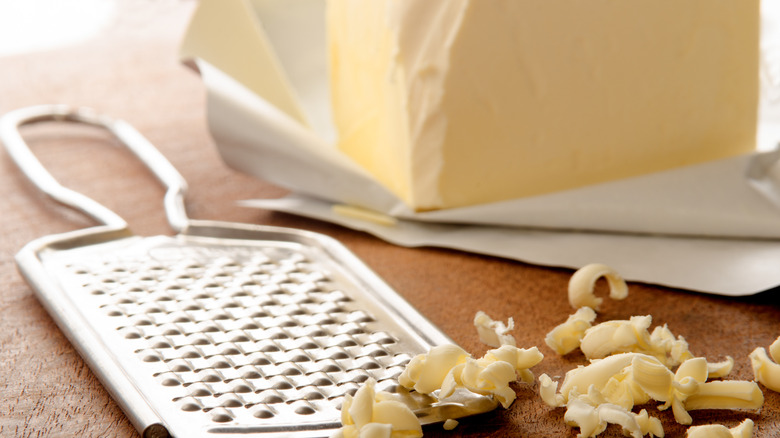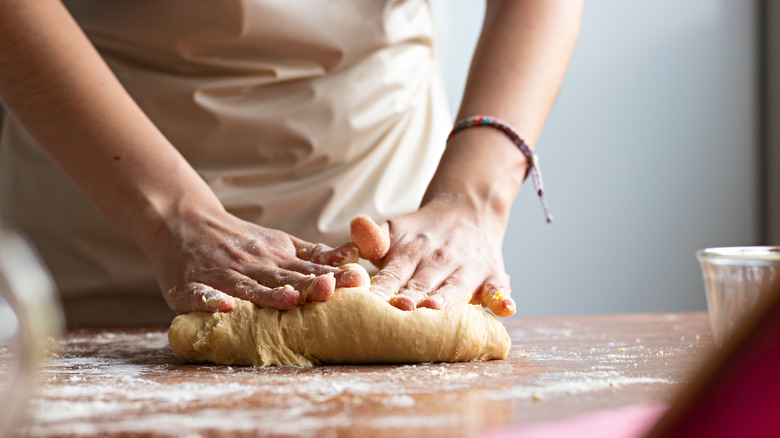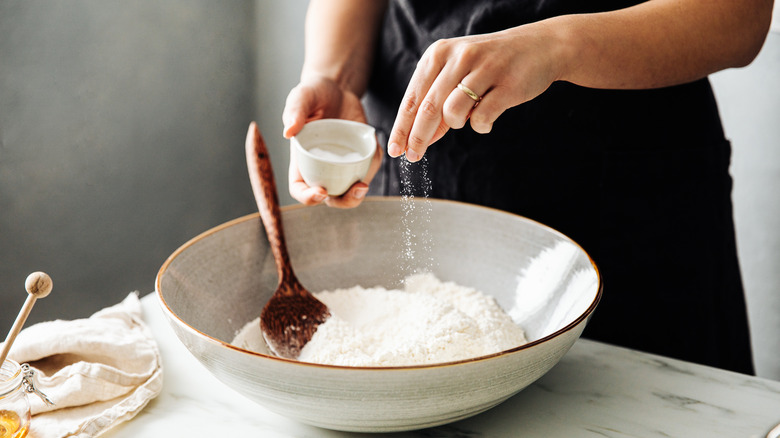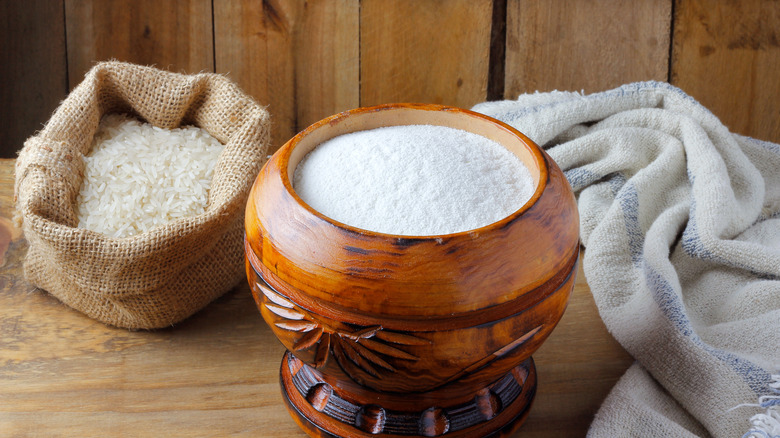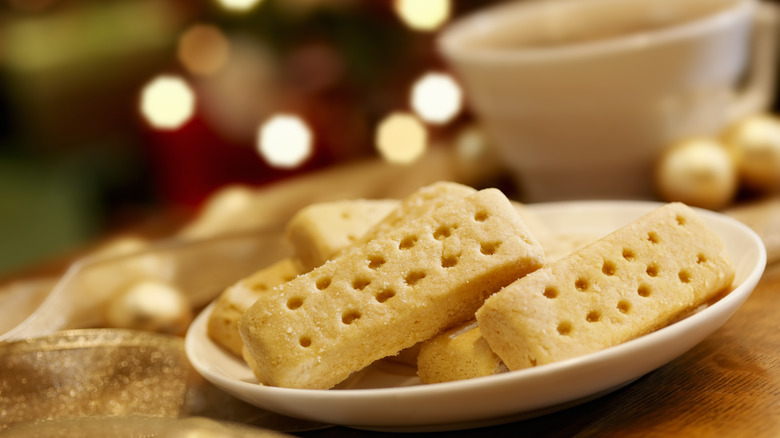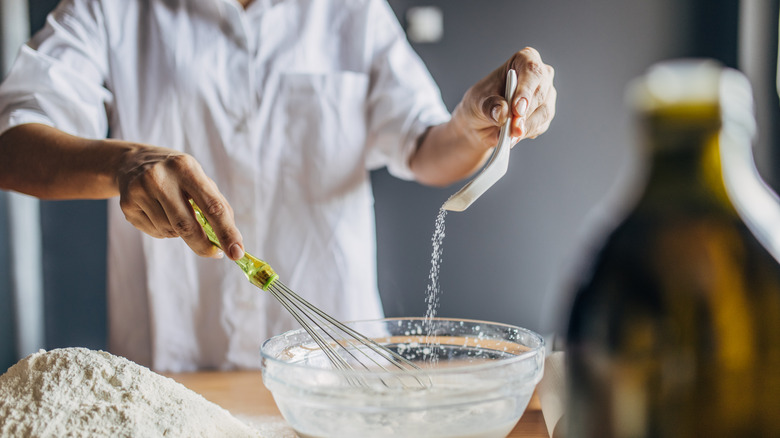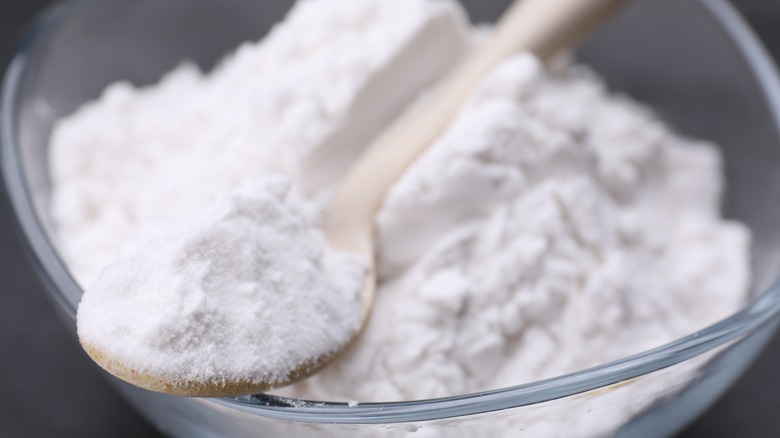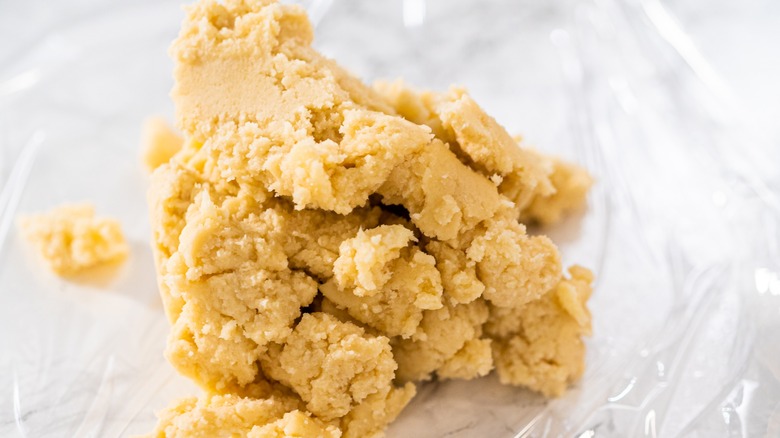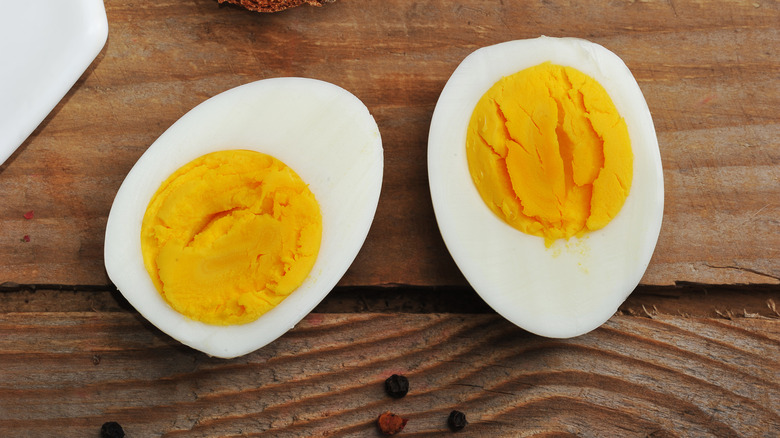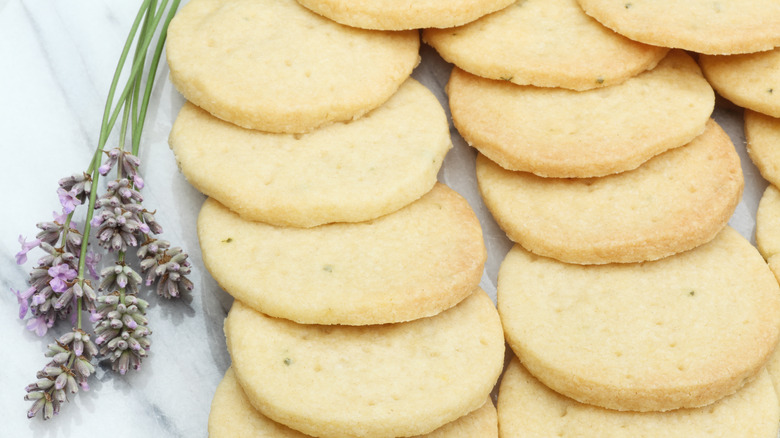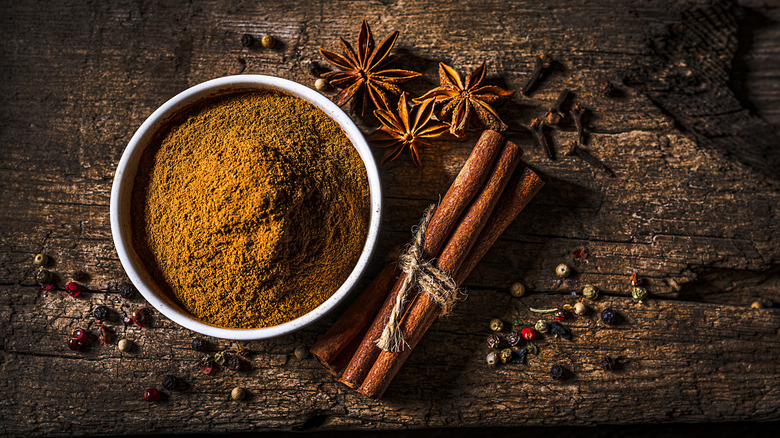19 Tips For Making High-Quality Shortbread
Shortbread cookies are something that every baker should know how to bake regardless of experience level. The ingredients are much simpler than other cookie recipes, as these cookies require only flour, butter, and sugar. There's no tricky leavening or difficult piping here either, but you can take your shortbread a step above by adding a drizzle of chocolate, nuts, or dried fruits to the batter or finished cookies. You can also use shortbread cookies as the base for other desserts, like crumbled up into a cookie crust for a cheesecake or as the bottom layer of the famed millionaire's shortbread (which tastes nothing short of a million bucks).
But, as we know, having fewer ingredients doesn't mean also lowering the difficulty of these cookies. In order to reach the desired "short" texture, you have to be careful about what ingredients you use, your methods, and your baking routine. Here are some of our tips for buttery, snappy shortbread that would win you the applause of any cookie aficionado.
Ensure your butter is at the same cool temperature
Butter is the critical ingredient for baking shortbread because it gives shortbread its "short" texture. Moreover, the major difference that sets shortbread cookies from other types of cookies is that the butter needs to stay solid rather than getting creamed with sugar. As a result, the shortbread cookie resembles more of a pie dough or a biscuit than a chocolate chip or oatmeal cookie.
When making shortbread, you'll want to ensure your butter is at refrigerator temperature. Having bits of butter that are slightly warmer will create pockets of melting that will disrupt an even texture throughout the dough. Even leaving the fat at room temperature for too long will prevent the shortbread cookie from developing the right consistency. So, work quickly and efficiently to ensure your recipe comes together.
Avoid making your shortbread too thick
Unlike standard cookie dough, which you can just roll into a ball and plop on a baking sheet, knowing it will spread, shortbread cookies need to have the perfect thickness to cook correctly. If you're preparing traditional Scottish shortbread, you'll want to keep it about ¾ of an inch thick. This is much thicker than a roll-and-slice sugar cookie — or really any other popular type of cookie. If you keep your dough any thicker, you risk the dough coming out of the oven raw. If it's any thinner, the cookie will have a crispy texture with the snap of a graham cracker.
The exact thickness of the cookie will depend on the pan size you opt for. The standard size is an 8-inch by 8-inch, but you will also see 9-inch baking pans used for a slightly thinner cookie.
Add water if your dough isn't coming together
Baking isn't just about measuring — it's also about troubleshooting what to do when your dough or batter just isn't the right consistency. According to celebrity chef Ina Garten, the best way to fix crumbly shortbread is to mix it with a little bit of water. The "Barefoot Contessa" host notes that one of the reasons why the consistency of your dough may be off is because butter has different hydration levels. Adding a teaspoon or two of water to the dough will help bring it together without upsetting the balance of flavors and ingredients in the recipe.
Flooding your shortbread with water is easy, so you should always stick to only a teaspoon or two at a time. Once all of the flour bits disappear, you won't have to add any more hydration for the dough to bake it perfectly.
Always bake the shortbread in a metal pan
Shortbread cookies are traditionally baked in a shortbread mold with elaborately printed designs. If you go with the mold, you're going to want to opt for a recipe made for pressing the dough into a baking pan rather than one that has the dough rolled out and sliced with a cookie cutter. This is because the dough that's made to be pushed in a pan can be more readily compacted, which will reduce unsightly seams.
The ideal pan material to use with pressed shortbread cookies is metal. It heats up more quickly than ceramic and won't hold as much heat, which will prevent browning. If you're using a mold or a baking pan, always spray with non-stick cooking spray before packing in your dough to ensure it releases easily once done.
Avoid baking the shortbread too hot
Does your shortbread taste bitter? It's likely not because you added an astringent element to the recipe. Instead, it's because there is an error in how hot or how long you baked your cookies. When the dough is baked too much, the butter starts to burn and produce those odd, unpleasant flavors. Be sure to stick with the time indicated on your recipe, even if your cookies don't take on a golden hue.
Another reason why your shortbread might taste a bit off is because your butter has gone rancid. Butter is known for being a pretty hearty ingredient with a relatively low water content. Plus, salted butter is inhospitable to bacteria. But, if you take a whiff of your butter or notice it has some odd color to it, you should open up a new package rather than take a chance on having bad stick in your shortbread recipe.
Explore beyond sweet seasonings
The base of a good shortbread recipe is flour, sugar, and butter. But that doesn't mean these are the only ingredients you should be including in your recipe. Pink peppercorn shortbread has a bright pop of spice and back-of-mouth heat to it, plus it complements the mild sweetness of the recipe. Meanwhile, the vibrant spice that gives shortbread cookies a tart bite is sumac. This Middle Eastern spice has a citrusy element to it, but not one that is reminiscent of a lemon or orange. It's a brightening element that will bring a burst of flavor without upsetting the liquid balance in your recipe.
If you're going a step further and making millionaire's shortbread, which features a thin buttery shortbread cookie layered with gooey caramel and chocolate ganache, you'll want to reach for tamarind. This paste can be easily added to the caramel for a sour, caramel flavor.
Grate the butter for your shortbread
A simple trick for better-textured shortbread is to grate the butter into the rest of the ingredients. This kitchen tool will allow you to place your block of butter in the freezer rather than the fridge and distribute it more evenly throughout your dough. These small flecks of butter will permeate the flour and melt together, which produces a short, buttery texture rather than a crunchy one.
In addition, a cheese grater is perfect when making shortbread dough because rather than compacting butter into a single mass, the technique creates small air pockets. These small spaces help create a light shortbread that has a little bit more give to it. The tool is ideal for shortbreads that you plan on dunking into tea or coffee or filling with flavorful spices like lavender or peppercorns.
Be careful not to overwork the dough
Gluten is the enemy of almost everything outside of the breadmaking world. And shortbread is no different. Several important chemical reactions occur when you overhandle or overmix the shortbread dough. The cold butter begins to melt and release its water content, which in turn causes the gluten to speed up formation and become elasticky. A little bit of gluten is okay because it forms the texture of the shortbread, but too much gluten will cause your cookie to go bread-like rather than be short and snappy.
There are several ways to tell that your shortbread dough has been overworked. Not only will the cookies appear tough when you bite into them, but they will also spread more during baking (which can be detrimental for roll-and-slice cookies. The flavor will also not be as buttery since the butter leaked out during the baking process.
When you're mixing the dough, be sure to do it only long enough for all of the ingredients to be combined with no pockets of dry flour. If the dough starts to crack when you bring it together, it's also a sign to put it in the fridge to let the gluten slack.
Don't be afraid of the salt
You can't be afraid of flavor in the kitchen, which includes basic seasoning. Not only do you need to add sugar to your shortbread, but you can't neglect to add a pinch of salt, either. The reason why many baking recipes call for table salt is because it mixes into the dough seamlessly without causing a baker to have to overmix the gluten. The comparatively small particle size of the table salt means that the ingredient can be well-distributed in the batter with very little effort compared with Kosher or rock salt.
Furthermore, adding salt to a recipe can help counteract some of the sweetness of the ingredients and make for a more balanced cookie. if you love the salty-sweet dichotomy, reserve some flaked salt for sprinkling on top of your shortbread.
Use rice flour for a crispier texture
One ingredient you'll often see in shortbread recipes is rice flour. This gluten-free flour is mixed with all-purpose flour to create a perfectly crisp Scottish shortbread that browns very little. Since the rice flour does not have the same gluten proteins as the all-purpose flour, it boosts the volume and the starch content of the flour without the risk of overdeveloping the gluten. A cookie that does not have as much rice flour is likely to become elasticky and tough rather than short and crisp. Other (but certainly less popular) variations will use gluten-free alternatives like oat flour, tapioca starch, or potato starch to achieve the same goal.
When shopping for your rice flour, you'll want to avoid purchasing the glutenous variety, which is totally different than rice flour and would be more useful for making mochi.
Prick the shortbread before baking
One of the easiest visual ways to identify shortbread from the array of other cookie types is the network of pinpricks on the surface. These marks are from a process called "docking," which means to gently stab the surface of the dough with a fork. This step is very important in making shortbread because it will allow the steam to escape from the butter as the shortbread bakes, in turn preventing the dough from rising and forming unsightly air bubbles and pockets. After all, you're not baking a flaky pie crust!
If you want to get a perfect shortbread texture without the visual distraction of the docking, try using your fork to make an elaborate design. Or you can decorate and serve the cookies with the other side facing upward.
Measure your ingredients precisely
Shortbread is so easy to bake, but any small changes in the proportions of ingredients will throw off your recipe and the texture of your cookie. It's essentially a 3-2-1 recipe: three parts flour, two parts butter, and one part sugar. Although this is a cookie recipe (and cookies are supposed to err on the sweet side), you need to avoid adding more sugar than absolutely necessary. If you use too much sugar in your dough, it will promote caramelization and darken the color of the cookie. Plus, when you bite into the cookie, it will be tough and crispy rather than soft and short.
There are some modifications if you want to make this recipe vegan. Since there are no eggs in the recipe already, you can just swap out the butter for vegan butter or hard margarine (not the spreadable stuff in the tub). It's important to remember that since margarine or vegan butter is made with 100% fat and doesn't have any water, the texture of your dough may change slightly.
Add cornstarch to keep your cookies dry
Cornstarch is a hidden weapon for crafting delicious shortbread. Adding a scant amount of this multipurpose ingredient to your dough will help soak up some of the residual moisture from the butter, which will slow the formation of gluten. However, if you add too much cornstarch to your recipe, you'll risk having a dough that is too dry and, therefore, won't stick together. You'll want to add this ingredient to the dough with the flour and the sugar to create the perfect texture.
Many recipes will use between ⅓ cup and ½ cup of cornstarch for each three to four cups of all-purpose flour. If you're using rice flour in your recipe or another gluten-free alternative, you may be able to cut this ratio down to ensure your cookie has the perfect amount of gluten formation.
Double-chill the dough to keep it solid
You heard it here from us: Always double-chill your cookie dough. There are numerous reasons why cookie dough (including both shortbread and drop cookies like chocolate chip) benefits from this technique. Placing the cookie dough in the refrigerator after it's brought together and again before it gets put into the oven will allow the butter to solidify back to a solid state. If you notice your dough is starting to get overworked, it's also a good time for the gluten to slack before you continue manipulating it.
In addition, placing the dough in the fridge for even 20 minutes while you're preheating the oven or working on other things will help concentrate the flavors. The water in the dough will evaporate in the fridge, which concentrates the sweet flavors as well as any flavorful additions you include in your shortbread.
Integrate savory sauces into shortbread
An unlikely companion to your shortbread cookies can be found with your other Asian ingredients. You can elevate the crave-ability of your shortbread cookies by adding fish sauce to the dough. You need to add only about half a teaspoon of the sauce to your dough; too much more, and you'll risk making the cookies too wet. Alternatively, you can also add the salty fermented sauce to a glaze with other bright ingredients like orange juice and lime.
When choosing a fish sauce, you'll want to find one made just with fish (often anchovies) and salt — no sugar or preservatives. You also may need to curb the salt in your dough to accommodate this particularly pungent and aromatic ingredient and ensure your dough remains on the sweet end of things.
Add hard-boiled egg yolks to keep your shortbread tender
A traditional shortbread recipe doesn't contain any egg, but that doesn't mean you can't break free from the standard recipe. Instead of adding a raw egg, as you would for most cookie recipes, you will use a little more unconventional method. For ultra tender shortbread, try adding hard-boiled egg yolk to the dough. You'll want to use the yolk (and only the yolk) of two hard-boiled eggs, passed through a sieve.
The science behind this creative addition is a little confusing, but we promise it will make all the difference in your recipe. Egg yolks are made of fat, and when sieved finely, they can be distributed evenly throughout the dough. The yolks act as a barrier between the flour molecules, preventing the gluten from forming long, complex strands and keeping your cookie short.
Bake your shortbread twice for the best color
Browned shortbread is not traditional by any means. But if you're aiming for a more caramelized, darker color on your cookies, you will want to bake them twice. It's the secret for beautifully browned shortbread, courtesy of Alice Medrich's cookbook "Pure Dessert." For her shortbread recipe, Medrich takes a step away from the traditional and utilizes melted butter instead of cold butter. For extra flavor, she also allows her dough to sit for a couple of hours to let the ingredients meld together.
Once her flour has hydrated and her sugar has better dissolved into the dough, Medrich recommends baking her shortbread in the oven. Then, while the cookies are still warm, she slices them and bakes them again for super crispy edges and a golden hue.
Use warming spices for unforgettable shortbread
Savory spices don't have to be the only spices you add to your recipe. The autumnal spices Ina Garten uses for unforgettable shortbread include cloves, cinnamon, and nutmeg. The host of the TV show "Barefoot Contessa" uses Eli Zabar's shortbread cookie base, which she told Delish was "the perfect shortbread." Besides making these cookies filled with warming spices, Garten shares that she's also used the recipe for a crust on her raspberry tart. During the cookie swap season, she'll stamp the cookies into shapes with a cutter and sprinkle them with a mixture of warm spices and sugar before they've cooled.
Garten also gets creative with other types of shortbread, including chocolate-dipped brown sugar shortbread, raspberry shortbread hearts, and classic pecan shortbread. We're impartial to the autumnal-spiced rendition, though.
Integrate shortbread into other desserts
Shortbread doesn't need to be relegated to the list of things you bake for the holiday season. It's actually a delicious component that you can hybridize to other recipes. "The Great British Bake Off" star Kim-Joy uses a shortbread layer to take her brownies up a notch. The whimsical cat lover not only adds a thin shortbread layer to the bottom of her brownies, but she also adds small cats made of shortbread to the top of each one, too.
Kim-Joy shared her brownie hack with feline-adoring friends on her TikTok page, noting that the shortbread provides a crunchy contrast to the chocolatey brownie. She lightly bakes the shortbread layer first before spooning the raw brownie batter on top and adding her shortbread cat cutouts to the top of the mixture. Cut your pieces carefully, and you'll have a cute and delicious brownie awaiting.
